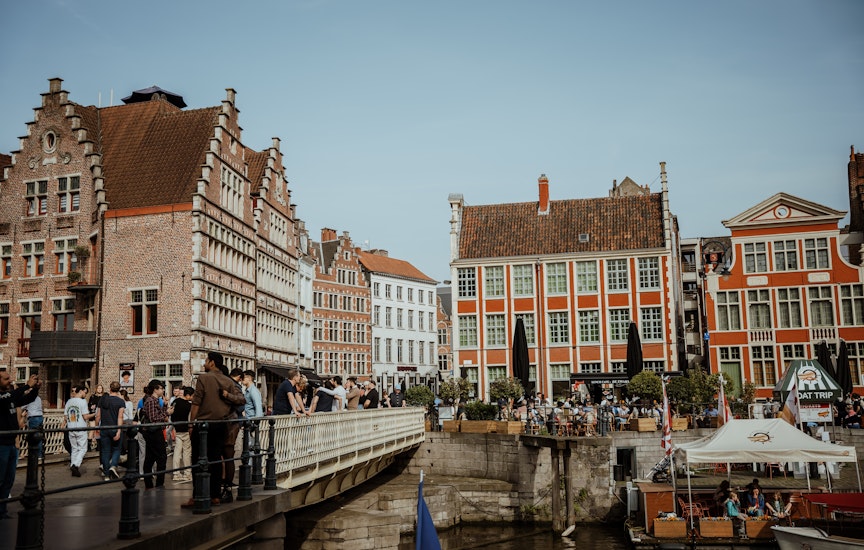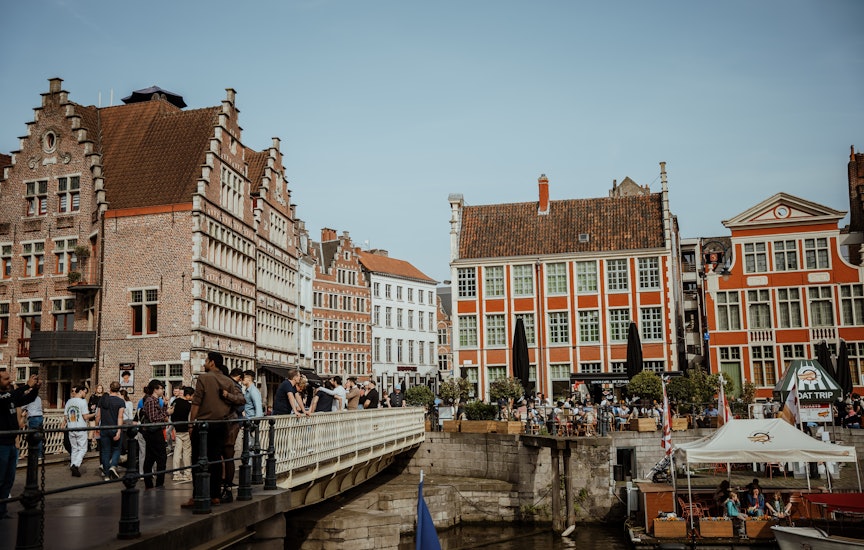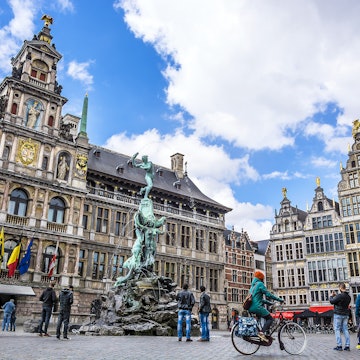

Grote Markt in Antwerp, Belgium at night
Antwerp has always been a singular place, something of an eccentric. Its reputation as a fashion and clubbing centre might only date back to last century but scratch the surface and you’ll find a port that’s always pushed boundaries. From master painter Peter Paul Rubens to the crashing drum ‘n’ bass of Rampage, Belgium’s biggest port has been setting trends for over 500 years. Could this be the most continuous cool city in the world?

A hotbed of illicit literature
When Christophe Plantin arrived in Antwerp in the 1540s, the wealthy port’s tolerance was way ahead of its time. The master bookbinder’s trade in the printed word was still so new that he risked being imprisoned or burnt at the stake if he continued to pedal his work in Paris.
Although Plantin’s blossoming bookbinding career came to a sudden end (his arm met with a random swordsman down a dark alley), he went on to establish a hugely successful and enduring printing business in Antwerp, whilst living an extraordinary life as a humanist and collector.
Remarkably, the legacy of Plantin and his son-in-law Jan Moretus still exists in situ—and almost entirely intact. The sublime Museum Plantin-Moretus is home to two of the oldest printing presses in the world and the original lead Garamond typeface made by Parisian engraver Claude Garamond. Naturally, its 17th-century bookshop is pristine.

Antwerp’s baroque star
While the city’s fortunes would waver over the next century, Antwerp never lost its worldly confidence and unique vision. Emerging from this milieu was its most famous son, the painter Peter Paul Rubens.
Set to celebrate Rubens’ genius in 2018, the Antwerp Baroque festival pairs the artist alongside a number of contemporary creatives. Painter Luc Tuymans, conceptualist Jan Fabre and choreographer Sidi Larbi Cherkaoui don’t just share a hometown with the baroque master—they revel in his dark, evocative palette and theatrical emotionality too.
The Rubenshuis shows off his best work (to remain in the city), including The Annunciation and one of only four self-portraits. As his former home and studio, the museum also includes paintings by contemporaries such as Anthony Van Dyck and plenty of domestic ephemera.
What’s more, the Rockoxhuis will reopen next year. This museum was home to the great collector and one-time Antwerp burgomaster (mayor) Nicolaas Rockox. It has paintings by Rubens, alongside works by Wildens and Pieter Brueghel the Younger. The renovated space will also incorporate the house next door, where still life painter Frans Snyders once resided.

When Flemish fashion took on the world
In 1986, six young designers (all graduates of Antwerp’s Royal Academy of Fine Arts) and a shoe-seller-turned-creative-director, drove a van to London and fronted up to the British designers’ fashion week showcase.
No one could pronounce their long Flemish names—or so the legend goes—and thus the Antwerp Six was born. Ann Demeulemeester, Dries Van Noten, Dirk Bikkembergs, Walter Van Beirendonck and Marina Yee all went home with orders from retailers like Barney’s New York and Liberty London, kick-starting a moment that epitomised the risk-taking fashions of the 1980s and ‘90s.
Alongside their old classmate Martin Margiela, the Antwerp Six made the nine-to-five shoulder pads and peplum dresses of Paris and New York look outdated. Instead, they used anti-glamour and affronting gender fluidity to reflect the edgy nature of their city.
Their legacy lives on across Antwerp. Walter Van Beirendonck heads up the fashion department at the Royal Academy, championing a new generation of Belgian designers like Raf Simons, Veronique Branquinho and Kris Van Assche.

In bohemian Zuid, opposite the grandeur of the Museum of Fine Arts, Ann Demeulemeester’s flagship store is an airy (if stark) stage, while Dries Van Noten’s Het Modepaleis occupies the most prominent corner of the fashion district. His lush fabrics and theatrical designs are juxtaposed against ancient wooden cabinets and brass fittings.
Just across the road from Dries’ emporium is MoMU, one of the most highly respected fashion museums in the world, with seasonal shows that have recently honoured both Dries Van Noten and Martin Margiela.
To take home some Antwerpen style, try independent retailers like Renaissance and Verso, or Coccodrillo and Elsa for shoes (the owners are both Dries Van Noten alumni). There’s also a serious vintage scene here, with dealers like Verlaine known globally for their coveted museum-quality pieces. Other excellent designer resellers include Rosier 41 and Label Inc, where you can pick up recent fashions at astonishing discounts.
Antwerp tears up the dance floor
When Technotronic’s Pump Up The Jam exploded onto dance floors in 1989, few knew where it came from and even fewer had an inkling of the scene that it represented. Its sound—new beat—grew out of the Belgian music scene, fusing house and hip-hop.
The film director Jozef Devillé alleged in his 2012 documentary The Sound of Belgium that the country’s astonishing electronic music scene—and it’s many offshoots such as EBM (electronic body music), house and techno—grew out of the transgressive folk traditions of carnivals, the Decap dance hall organs and the countryside tea dances of the 1960s and ‘70s.

Antwerp’s music scene has always been a passionate one; flush with fashion and art students as well as prostitutes, sailors, and the odd wayward diamond merchant. Set in a 16th-century church, Café d’Anvers is among its finest nightclubs. It still draws crowds to the city’s red-light zone, nearly 30 years after it first opened.
Café Beveren is home to the city’s last Decap organ, which belts out old school tunes to enthralled dancing crowds, but the trendy throngs tend to head to Pekfabriek. This late-night party spot in Borgerhout takes place in a converted pitch factory.
Belgium’s roster of summer music festivals are also well represented here in Antwerp (besides the huge EDM party Tomorrowland): Rampage ramps up the drum ‘n’ bass and dubstep; Dystopia is for house music fans; Summerfestival deals in electronica; and Laundry Day offers a dose of hip-hop.
Antwerp's sustained commitment to musical diversity is a classic example of the city's refusal to rest on its laurels when it comes to cultural innovation. This independent spirit makes it a strong contender to continue as one of the coolest cities in the world for at least another 500 years.














